In the Czech Republic, trdelnik is incredibly popular, especially among foreign tourists who buy this sweet dessert from stallholders in the center of Prague. And today, I have a recipe for you to bake trdelník at home from scratch.

➜ What is Trdelnik
Trdelnik is a traditional old Bohemian sweet pastry made of yeast dough. Strips of dough are rolled onto a cylinder (called trdlo) and baked over hot coals. Baked trdelnik is coated in sugar mixed with cinnamon or nuts.
Trdelnik belongs to the typical delicacies of Prague markets and fairs.
Want more authentic Czech sweet treats? Try out Prague kolach cake (found in Prague bakeries only!)
➜ Origin
The trdelnik comes from the Moravian-Slovak border area. The Slovaks often refer to it as their national recipe, just like the Czechs.
In the Slovak town of Skalica, they have been granted the protected geographical indication 'Skalický trdelník' by the European Union.
➜ Pronunciation
I recorded a short audio clip with the pronunciation of the word trdelnik (spelled correctly trdelník in the Czech language). I am a native speaker, so you get an idea of how to pronounce trdelnik in Czech!
TIP: English speakers use the name chimney cake for trdelnik pastry.
➜ Trdelnik mold
Probably none of us has an original mold for baking a trdelnik over burning coals at home. Fortunately, there is a good trick to replace the classic trdlo cylinders.
➤ A tin can, somewhat narrower and taller, which you wrap with foil, will serve well for homemade baking trdelnik. You roll the strips of dough onto the prepared tin with light pressure to stick to each other and the tin.
Put the prepared pastry in the oven, and you're done!
TIP: I used Tescoma sticks that I recently got as a gift for my kitchen.

Enough talk, let's bake!
➜ Ingredients

To make Prague trdelník, we need:
- All-purpose flour; read more about types of Czech wheat flour.
- Milk; lukewarm
- Lard; melted/softened
- Butter; melted/softened
- Granulated sugar
- Active dry yeast
- Egg yolks
- Pinch of salt
FOR THE COVERING:
A tablespoon of melted butter, granulated sugar, and ground cinnamon.
✅ You’ll find the exact amount of ingredients below in the recipe card, which you can also print out.
➜ Instructions with Photos
Before you start baking: prepare the mold for the trdelnik - either from Tescoma or wrap the cans with the foil and brush them a bit with butter.
STEP 1: Heat the milk until lukewarm. Pour in the dry yeast and a little sugar, stir. Leave in a warm place for 10 minutes to activate.

STEP 2: Put the flour in a large bowl. Add the rest of the sugar, a pinch of salt, the egg yolks. Allow the butter and lard to melt (in a pot on the stove or in the microwave) and add to the bowl. Finally, pour in the risen yeast mixture.
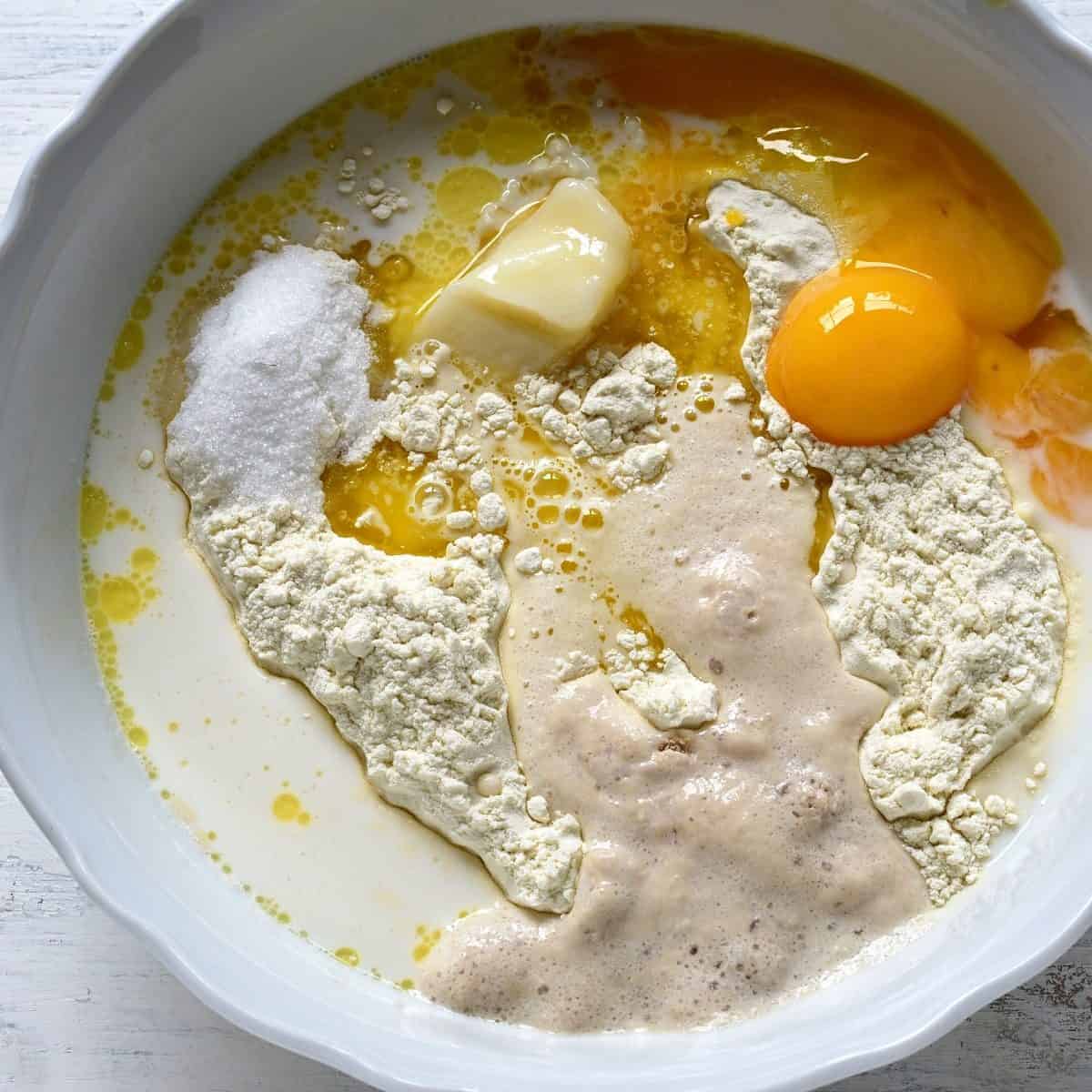
STEP 3: Work the ingredients into a smooth dough. I work with my hands, I don't use a food processor. I add a little flour at a time as needed if the dough sticks to the bowl too much.
Once the dough is smooth and elastic, allow it to rise in a warm place for 45 minutes.
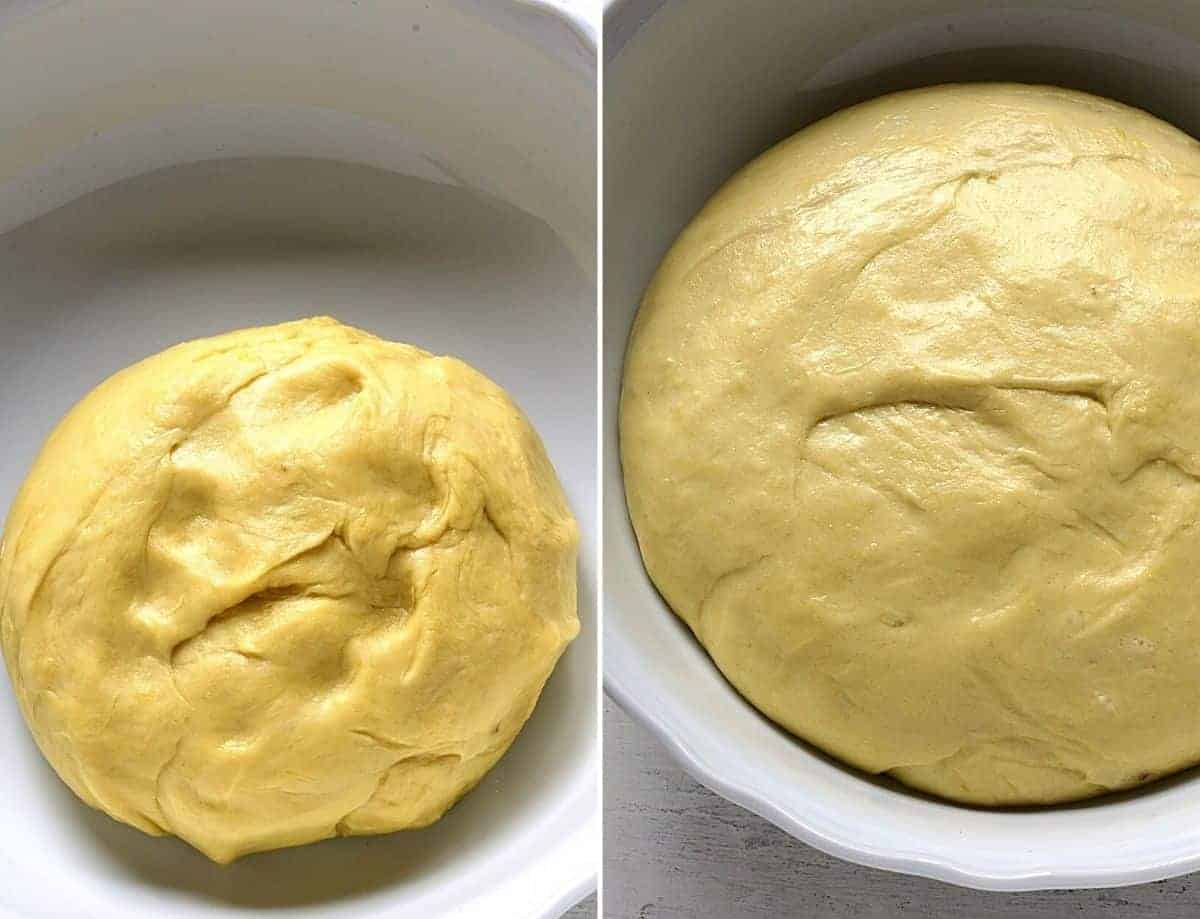
TIP: I usually let yeast dough rise in a turned-off, closed oven with a pot of hot water placed in the bottom.
⤍ Learn how to make dough rise in the oven.
STEP 4: Divide the risen dough into pieces and roll out strands about ½-inch (1-1.5 cm) thick. Roll them on the sticks (e.g., a can be wrapped in foil), tucking the ends under the strand to fix them. If you connect more strands in one trdelník, press them well against the end of the last strand.

Slightly roll and flatten the mold with wound strands. The dough will stick to the form and each other and will hold better when baking.
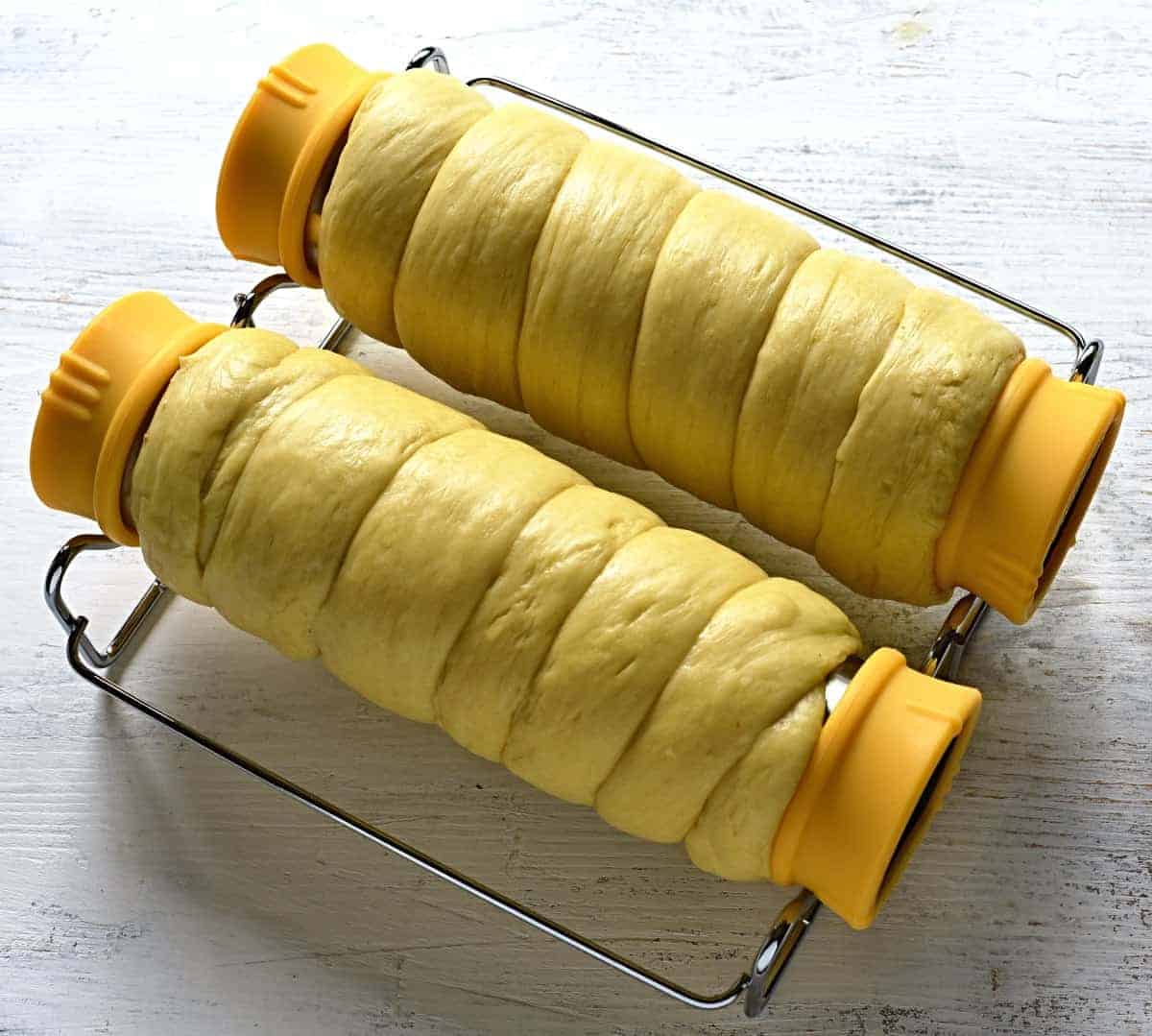
STEP 5: Place in a preheated oven at 360 °F (180 °C) for 20 minutes.
IMPORTANT: If you are using a Tescoma mold, turn the cylinder with the rolled dough while baking by a third every 5 minutes or so!
STEP 6: Meanwhile, put the sugar and a little cinnamon in a baking dish, stir. Carefully remove the baked trdelnik and brush it with melted butter. Coat all sides in sugar, pressing well.

➜ Serving
Trdelnik tastes best while still warm. Unwrap the strands gently and enjoy this old-country Czech delicacy!

➜ Useful Tips
- Add a tablespoon of rum to the butter when brushing the baked pastry for a better aroma.
- Mix coarsely chopped walnuts into the coating mixture. Trdelnik will be crispier.
- In Prague, you can have your trdelnik filled with chocolate spread or ice cream on request. We tried it once, and frankly, I don't recommend this combination because the chocolate and ice cream melts quickly on the hot pastry, and you won't have time to enjoy it. Of course, the final decision is yours!
More Czech sweet recipes:
Or browse this category with Czechoslovakian desserts, where you’ll find more inspiration.
Tried this recipe?
Leave a review down in the comments! ⭐⭐⭐⭐⭐
Follow me on Facebook and Pinterest. Subscribe to my newsletter. Send me any question about Czech cuisine to my e-mail. I love hearing your feedback!

Czech Trdelnik Recipe
Ingredients
- 2 and ¼ cups all-purpose flour (290 g)
- ⅔ cup milk (160 ml) lukewarm
- 2 Tablespoons lard or unsalted butter (30 g)
- 2 Tablespoons unsalted butter (30 g)
- 1 Tablespoon granulated sugar
- 1 and ½ teaspoon active dry yeast
- 3 egg yolks
- pinch of salt
For coating:
- 6 Tablespoons granulated sugar
- ½ teaspoon cinnamon ground
- 1 Tablespoon butter melted
Instructions
- Before you start baking: prepare the mold for the trdelnik - either from Tescoma or wrap the cans in foil and brush them with butter a bit.
- Heat the milk until lukewarm. Pour in the dry yeast and a little sugar, stir. Leave in a warm place for 10 minutes to activate.
- Put the flour in a large bowl. Add the rest of the sugar, a pinch of salt, the egg yolks. Allow the butter and lard to melt (in a pot on the stove or in the microwave) and add to the bowl. Finally, pour in the risen yeast mixture.
- Work the ingredients into a smooth dough. I work with my hands; I don't use a food processor. I add flour a little at a time as needed if the dough sticks too much.
- Once the dough is smooth and elastic, allow it to rise in a warm place for 45 minutes.
- Divide the risen dough into pieces and roll out strands about ½-inch (1-1.5 cm) thick. Roll them on the sticks (e.g., a tin can wrapped in foil), tucking the ends under the strand to fix them. If you connect more strands in one trdelník, press them well against the end of the last strand.
- Slightly roll and flatten the form with wound strands. The dough will stick to the form and each other and will hold better when baking.
- Place in a preheated oven at 360 °F (180 °C) for 20 minutes.
- Meanwhile, put the sugar and a little cinnamon in a baking dish, stir. Carefully remove the baked trdelnik and brush it with melted butter. Coat all sides in sugar, pressing well.
Notes
- Makes 2 big trdelniks, it is enough for 4 people.
- SERVING: Trdelnik tastes best while still warm. Unwrap the strands gently and enjoy this old-country Czech delicacy!
- Add a tablespoon of rum to the butter when brushing the baked pastry for a better aroma.
- Mix the coarsely chopped walnuts into the coating mixture. Trdelnik will be crispier.
- In Prague, you can have your trdelnik filled with chocolate spread or ice cream on request. We tried it once, and frankly, I don't recommend this combination because the chocolate and ice cream melts quickly on the hot pastry, and you won't have time to enjoy it. Of course, the final decision is yours!
DISCLAIMER: Because I come from Central Europe, my recipes are based on metric units such as grams or milliliters. Check out how I convert metric units to the U.S. system:
Conversion chart



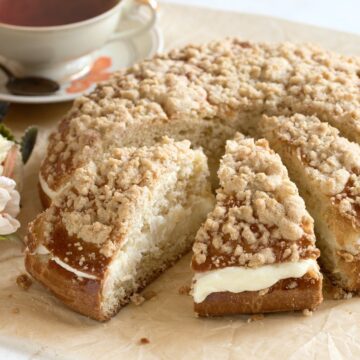
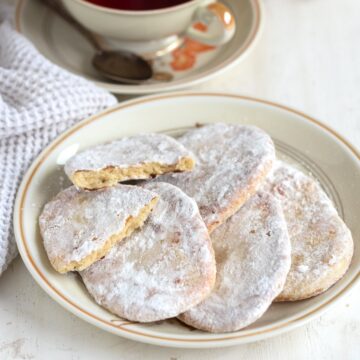
Ema
Český trdelník? Trdelník je buď slovenský alebo maďarský, určite nie český. V živote som nestretla Čecha, ktorý by niečo také trvdil (okrem predavačov trdelníkov v Prahe, ktorí to chcú predať turistom).
Petra Kupská
V článku uvádím, že trdelník pochází z moravsko-slovenského pomezí. Jako zdroj mi posloužil Chuťový místopis od Marie Úlehlové-Tilschové, která je mj. autorkou bestselleru Česká strava lidová. M.Ú.T. se zabývala stravováním v českých zemích v druhé polovině 19. století a začátkem století 20. Zmiňovaný Chuťový místopis byl vydaný v roce 1970, jedná se regionální kuchařku s řadou původních receptů. Přikládám odkazy na tři zkopírované stránky, které se trdelníku věnují.
Trdelník 1
Trdelník 2
Trdelník 3
stephen
Hello Petra,
I have recently received Trdelník (chimney cake) electric grill from my work colleagues on my 25th work anniversary. I had once mentioned to them that at the end of my stressful international career I would like to return home and start a chimney food truck! Now my question would be is there a baking school in Prague you would recommend so for an extended course on the art of baking Trdelník?
Thank you very much
Stephen
Maya
Amazing recipe! I was missing these after my trip to Prague earlier in the year and this recipe takes me straight back! They also smell amazing whilst cooking.
Petra Kupská
Thank you, Maya! I hope you enjoyed your stay in Prague, it is a wonderful city! 🙂
Madeline
Super easy to follow recipe -- I got it right on the first try! Thanks so much for posting this, I thought I'd never get to have them outside of visiting Czechia <3
Petra Kupská
Thank you very much, I hope you enjoyed the Czech Republic a lot! 🙂
Alexandru
Since it’s not actually a traditional Czech dish you can have it in a few other Eastern European countries like Slovakia and Romania where it’s been cooked for longer. It is damn tasty though!
Petra Kupská
It's not that simple with the origin of trdelník. I have records from a cookbook from the early 20th century, when trdelník was served in the eastern part of Moravia, specifically in the Slovácko region (the present-day Czech Republic). It probably came there from today's Slovakia. Of course, at that time, most of central Europe lived under the Austro-Hungarian Empire, and modern states as we know them today did not exist. People migrated back and forth and, of course, brought with them folk customs and regional foods. But as you say, trdelník tastes great whether you eat it in Prague, Bratislava or Budapest!
Allie
I'm so looking forward to trying this! We were introduced to these delight on our honeymoon, and took to calling them "Turtlenecks," because we were uncertain of the pronunciation. Sooooo good! ^_^
PS: Ten years today!
Anicka Cooklikeczechs.com
Congratulations on the anniversary! I hope you will like the homemade ones just as much.
You named them amusingly 🙂
Monique Sanchez
ITS NOT CZECH!
Petra Kupská
What makes Czech food Czech? I don't understand why someone keeps saying that trdelník is not Czech. Apparently under the impact of Youtube influencers? Trdelník is a dish that was demonstrably served in the eastern part of today's Czech Republic in the 19th century, there are records of it. It was served as a sweet treat to mothers after childbirth to make them stronger. And that there is a similar food in other European countries? It's true. Few things in the world are completely original. Besides, the center of Europe was once a place where nations, their cultures, and their cuisines mixed. Please, before you make any proclamations, look for reliable sources first.
mertimor
Egy kis történelem. Ennek a desszertnek a magyar nevei: dorongos fánk, dorongfánk, botra tekercs, kürtősfánk, kürtős pánkó, fánsült kalács, kürtőskalács. Ezek mind ugyanannak a süteménynek a nevei. Ezek a sütik nem egyforma tecnhikával, recepttel és nem egyidőben készültek. Magyar nyelven először 1723-ban említik
egy levélben. Erdélyből származó és a moldvai fővárosban, Jászvásárban élő úrhölgy, gróf Feratti Bertalanné, a moldvai vajda feleségének kérését tolmácsolja a székelyföldi Torján élő nagynénjének, Apor Péterné Kálnoki Borbálának egy levélben, arra kérve őt, küldjön egy inast, aki ismeri a kürtőskalácssütés fortélyát.
Anicka Cooklikeczechs.com
Jó napot, thank you for your comment and interesting facts from the hungarian cuisine! Greetings from the Czech Republic. (not gonna lie - I used an online translator :))